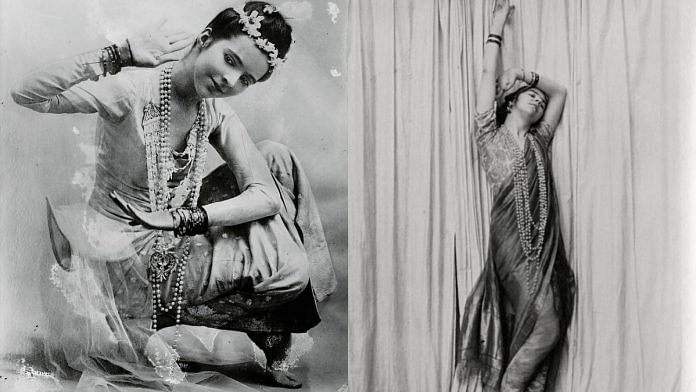An image of a fair-skinned woman with thick, striking jet black hair flying behind her as she strikes a dance pose is one of the most common pictures of Olive Katherine Craddock. In two other black and white pictures, Craddock strikes another pose in a saree and matha-patti. She looks extremely comfortable. However, there is something that stands out. One can tell she is extremely well-versed with the styles of dance, but the question is where Craddock is from.
Craddock, an Anglo-Indian born in 1892 in Kolkata, was known for taking the ‘central-Indian’ and ‘oriental’ style of dancing across the world. Born to a British mother and Anglo-Indian father, she was only 17-years-old when she left for Britain to dance professionally. Along with Ruth St. Denis, Craddock is credited for incorporating the ‘Indian dance’ in the world of Western theatre.
In 1926, a reviewer Alma Talley wrote in The Dance magazine: ‘Roshanara has brought to the Western World the spirit of Central India as no one else has ever been able to bring… India’s dances were a part of her soul. She devoted her life to perfecting them, as an artist in water colours gives years of study to making his art as nearly perfect as perfection is humanly possible.’
Craddock adopted the name ‘Roshanara’ in 1909, as she left India, after the Mughal princess and Shahjahan’s daughter, which meant ‘Light-Adorning’. This would go on to be her stage name. In 1911, Craddock (now Roshanara) studied under Carmen Tórtola Valencia, a Spanish dancer and choreographer. She also danced with American actress and dancer Loie Fuller’s company and shortly after, performed in a play called Kismet directed by Australian actor and writer Oscar Asche at the Garrick Theatre in London. She also starred five times as Zobeide in Schéhérazade for the Ballets Russes at Covent Garden, London.
Also Read: Uday Shankar: Father of modern Indian dance who never learnt how to dance
The ‘oriental’ dancer
Roshanara was reviewed in Variety magazine in 1914 after she did an ‘incense dance, a village dance, warrior dance, and a snake dance’. The reviewer gave her credit for “pulling off an old idea anyway”.
In her own words, speaking about the ‘oriental’ dance form, written in the book ‘Secrets of Oriental Grace’ (in 1925), Roshanara said: “The Oriental dancer is the only true interpretive dancer for it is possible with her movements, to interpret any story or feeling that she may wish.”
Roshanara had a successful career while she was in Britain. In 1912, she performed at the Palace Theatre in London and even managed a spot on Russian prima ballerina Anna Pavlova’s Britain tour. Known mainly by her stage name now, Roshanara even performed for two week at the London Coliseum (London’s largest and most luxurious “family” variety theatre).
Also Read: Rukmini Devi: Legendary Bharatanatyam dancer who could have been President
Roshanara’s move to the US
In 1916, Roshanara made her move to the United States. Not one to be restricted by any form of dance, in the US, she appeared in Vaudeville theatres (a type of entertainment that combined burlesque comedy and song and dance). And was also a speciality dancer at Adolph Bolm’s company – Ballet Intime. Bolm was a ballet dancer who partnered with Pavlova and later went on to become a choreographer and helped in setting up the Ballet Theatre in New York.
Roshanara also went on to teach dancing when she moved to New York in 1923. While she taught many the art of dancing, including popular actor Bette Davis, she never started her own school unlike other contemporaries like Ruth St. Denis. Some believe this is precisely the reason why Craddock’s dances did not become as popular as Denis’. Author and dance critic Deborah Jowitt argues, however, that Roshanara might not have learned her ‘oriental’ technique from India and instead replicated Denis who had performed a similar style years before.
Although she succumbed to appendicitis on 16 July 1926 only when she was 34, her legacy as a dancer who brought ‘Indianness’ to Western audiences remains as a relic of her dedication to performance art.
(Edited by Srinjoy Dey)



